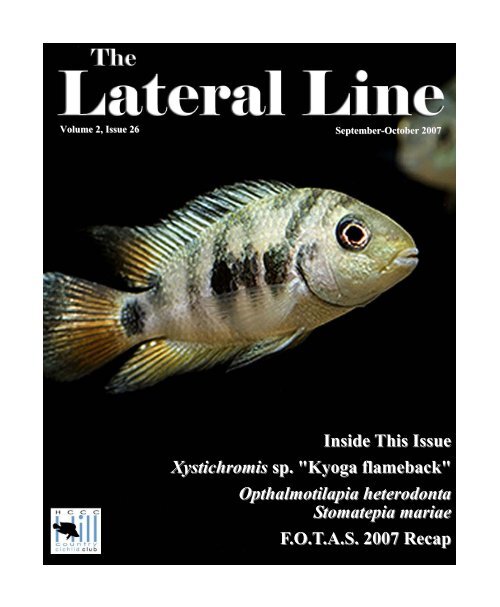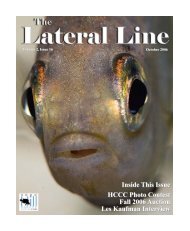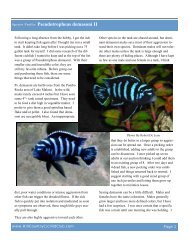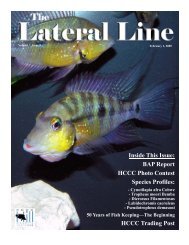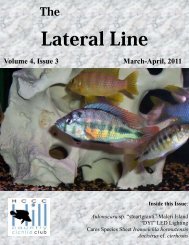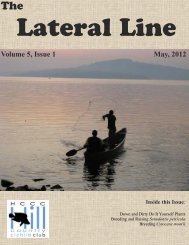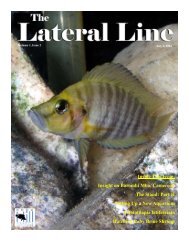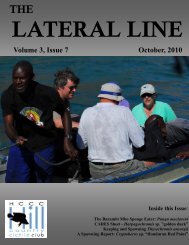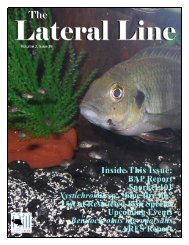September/October - Hill Country Cichlid Club
September/October - Hill Country Cichlid Club
September/October - Hill Country Cichlid Club
You also want an ePaper? Increase the reach of your titles
YUMPU automatically turns print PDFs into web optimized ePapers that Google loves.
Volume 2, Issue 26<br />
<strong>September</strong>-<strong>October</strong> 2007<br />
Inside This Issue<br />
Xystichromis sp. "Kyoga flameback"<br />
Opthalmotilapia heterodonta<br />
Stomatepia mariae<br />
F.O.T.A.S. 2007 Recap
The Lateral Line Page 2<br />
BAP Report<br />
August entries contained a month of firsts. Congratulations to Kevin<br />
(Sir BlackhOle) on his 1st of species spawning of Parachromis<br />
managuensis. This is a very large fish and his article on the caring<br />
and breeding of this species should be very interesting. Congrats<br />
Kevin.<br />
<strong>October</strong> 10, 2007<br />
INSIDE THIS<br />
ISSUE:<br />
X. sp. "Kyoga flameback" 4<br />
Opthalmo. heterodonta 7<br />
F.O.T.A.S. 2007 10<br />
Stomatepia mariae 16<br />
Upcoming Events 19<br />
Another 1st of species entry was submitted by Kenneth (Shelload)<br />
on the Dimidiochromis compressiceps. Kenneth entered the BAP in<br />
March and this is his 3rd entry of a 1st of species. Most important<br />
was the fact that this was his 5th entry into the program and qualifies<br />
him for the Breeders Award. Great work Kenneth on your accomplishments.<br />
Although the fry are 2 months old they still may be too<br />
small for transporting, but check with him. Kenneth also submitted<br />
two more entries, the Labidochromis caeruleus and the Aulonocara<br />
hueseri. Congrats Kenneth on your entries, keep them fry coming.<br />
It would not be a BAP month if we did not hear from Greg (GAS).<br />
And he has not disappointed us by entering another 1st of species.<br />
Congratulations on the Ctenochromis horei, which is a large and<br />
aggressive fish. If you're interested in the fry be prepared to have a<br />
large tank and plenty of refuge for the females. Congratulations<br />
Greg.<br />
Congratulations go out to Dan (dwschacht) on his first entry in the<br />
BAP. His first entry consisted of two entries, one was the Labidochromis<br />
caeruleus and the other was the Pseudotropheus acei, white<br />
tail. Congrats again Dan on your first two entries in the BAP.<br />
Cover Photo:<br />
Archocentrus sp.<br />
“Honduran Red<br />
Point”<br />
By Dave Hansen<br />
Congrats to all the 1st for August. <strong>September</strong> will host a 1st for the<br />
HCCC with the upcoming FOTAS Convention. Hope to see you<br />
there.<br />
Standings on Page 19.<br />
■ Jim Beck
The Lateral Line Page 3<br />
HCCC Monthly Photo Contest<br />
First Place<br />
Dave Hansen<br />
Benitochromis nigrodorsalis<br />
Second Place<br />
Dave Hansen<br />
Pseudocrenilabrus multicolor<br />
multicolor<br />
Thrid Place<br />
Dave Hansen<br />
Steatocranus gibbiceps
The Lateral Line Page 4<br />
Species Profile:<br />
Xystichromis sp. "Kyoga flameback"<br />
The Kyoga Basin in Uganda is a large portion<br />
of the Victorian Nile drainage system. Situated<br />
North of Lake Victoria, Lake Kyoga is the<br />
main body of water with many surrounding<br />
shallow bays and isolated finger-lakes. Lake<br />
Nawampassa is situated in the south east portion<br />
of this region and is separated from the<br />
main Kyoga waters by a thin strip of swamp.<br />
Lake Nawampassa is home not only to species<br />
found throughout the Kyoga Basin, but also to<br />
several endemics. Due to environmental fragility,<br />
all species from this region are considered<br />
threatened. Most of the cichlid lineages found<br />
in Lake Victoria have representatives in the<br />
Kyoga region and into Nawampassa.<br />
For the hobbyist, the furu from Kyoga are<br />
sought after due to their small size, adaptability<br />
to captive life and coloration (they are among<br />
the most colorful cichlids on the planet). These<br />
fish are not regularly seen at your local store so<br />
it may take some effort and digging to locate<br />
them. One such species is the vibrant Xystichromis<br />
sp. "Kyoga flameback".<br />
This species was first discovered in Lake<br />
Nawampassa by Julian Whitehead (in all<br />
probability) and later located by Les Kaufman,<br />
who gave this species the cheironym<br />
"Kyoga flameback". This may be a misnomer<br />
as it is uncertain if the Kyoga Flameback is<br />
actually found in Kyoga proper. X. sp.<br />
"Kyoga flameback' is not to be confused with<br />
Xystichromis sp. "flameback" that was discovered<br />
at Kisumu Kenya in 1989 by Dr. Kaufman.<br />
The latter species has a wide distribution<br />
within Lake Victoria and sports differing<br />
body markings. The Victorian flameback is a<br />
smaller species and a generalized feeder as is<br />
its Nawampassian cousin. To add to the confusion<br />
level, X. sp. "Kyoga flameback" is<br />
known by the trade name Haplochromis sp.<br />
"all red" Nawampassa. This cichlid is sometimes<br />
confused with Haplochromis sp. "all<br />
red" from Lake Edward. I feel that to avoid<br />
unnecessary misidentifications, one should<br />
refer to the fish as X. sp. "Kyoga flameback"<br />
(the original field name) and drop the<br />
other monikers.<br />
Dave’s Rare Aquarium Fish<br />
a proud supporter of the HCCC<br />
5121 Crestway Drive Suite 300<br />
San Antonio, TX 78239 (210) 599-9444<br />
Member discounts<br />
www.DavesFish.com<br />
Xystichromis sp. "Kyoga flameback" has<br />
an elongated, laterally compressed<br />
"haplochromine" body shape. The cranial<br />
profile is straight or slightly convex<br />
with large eyes and a medium sized<br />
mouth. There is a broken and thickened<br />
mid lateral black bar running the length<br />
of the body from the caudal peduncle to<br />
the gill plate. In regards to male coloration,<br />
the top portion of the body, includ-
The Lateral Line Page 5<br />
ing the head is scarlet red. The lips and lower<br />
portion of the head is blue. The bottom portions<br />
of the flanks are lime-green and yellow.<br />
The dorsal fin is red foremost fading to blue at<br />
the rear while the caudal fin has blue streaks at<br />
the base flowing to completely red at the extremities.<br />
The anal fin is white-blue becoming<br />
red at the outer portion. The pelvic fins are jetblack.<br />
There is a straight black bar beginning<br />
at the corner of the lips and continuing through<br />
the eye. Female coloration is an<br />
unassuming tan-brown with the<br />
same markings found on the<br />
males. The lower jaw protrudes<br />
slightly beyond the upper. Bicuspid<br />
dentition is found in all but<br />
large adult males who show some<br />
unicuspid teeth in the outer rows.<br />
Wild populations are opportunistic<br />
insectivores who diet also consists<br />
of plant matter. Both sexes<br />
have an adult size of 12cm. These<br />
aspects are all consistent with the<br />
genus Xystichromis. Further research<br />
may result in a different or<br />
completely new designation, but for the time<br />
being, this seems to be the best fit.<br />
Xystichromis sp. "Kyoga flameback", is for the<br />
most part, a peaceful aquarium resident. Males<br />
will become aggressive among each other with<br />
the onset of spawning but in general remains<br />
rather placid. Despite its size (comparatively<br />
speaking) the Kyoga flameback can be easily<br />
bullied by other species so care and observation<br />
is crucial when choosing tank mates. I have<br />
been able to maintain the oral shellers with X.<br />
sp. "Kyoga flameback" devoid of incident.<br />
These species include Ptyochromis sp.<br />
"salmon", Platytaeniodus sp. "redtail sheller",<br />
and Haplochromis sp. "Kenya gold". I have<br />
tried working Pundamilia pundamilia and<br />
Pundamilia sp. "blue bar" in the mix but I<br />
believe these to be a little too boisterous and<br />
the X. sp "Kyoga flameback" failed to fully<br />
color.<br />
To successfully maintain X. sp "Kyoga flameback",<br />
one should house a colony in a tank of<br />
Photo by Dave Hansen<br />
no less that 40 gallons, preferably larger. A<br />
sand or small grain gravel substrate is favored<br />
as this cichlid enjoys "scooping" at the bottom<br />
while sifting for food. This vertical "head<br />
plunging" is a constant leisure activity. I employ<br />
some rockwork into all my tanks but this<br />
is for pure aesthetics as X. sp "Kyoga flameback",<br />
when content with its environment,<br />
prefers open areas. As with all responsible<br />
aquatic husbandries, adequate filtration and<br />
frequent water changes are required to keep<br />
this fish, as well as all others, in prime condition.<br />
Feeding should consist of a high quality
The Lateral Line Page 6<br />
flake containing both protein and vegetable<br />
matter although a diet of spirulina flake with<br />
frozen or live brine shrimp, daphnia, or the<br />
like, is also suitable.<br />
At 6cm, males will begin to display the red<br />
coloration for which they are known. This<br />
usually occurs at seven months of age. Male<br />
coloration indicates sexual maturity so the first<br />
attempt at spawning takes place soon there<br />
after. The act of spawning is typical of the<br />
Photo by Dave Hansen<br />
haplochromines from the region. The males<br />
color intensifies while claiming and defending<br />
a small territory. This region is concentrated<br />
around some object (usually a rock). The male<br />
will dart at the ripe female and dance tilted to<br />
one side displaying his fully extended fins. She<br />
will eventually enter his territory and the two<br />
will begin circling each other. The male tilts so<br />
that his anal fin is laying on the substrate. The<br />
ocelli resemble the female's eggs in both color<br />
and size. As she nips at the egg spots, the male<br />
releases milt. She drops a small number of<br />
eggs and quickly turns to pick them up into<br />
her mouth. This process continues until she<br />
has fully expelled. She then leaves the spawning<br />
area to find a quiet area in which to brood<br />
her clutch. After 18 days (gestation period is<br />
dependant on water temperature) the larvae<br />
have fully absorbed their egg sac and the female<br />
releases her fry for a short spurt, to forage.<br />
Over the next two weeks the female releases<br />
her brood more often scooping them<br />
back into her buccal cavity when<br />
she feels they are in danger. The<br />
young will eventually be left to fend<br />
for themselves. Brood sizes are<br />
large and can number in excess of<br />
50. To ensure survival, we raise the<br />
fry in a separate tank where they<br />
grow quickly on a diet of finely<br />
crushed flake and Cyclop-eeze®.<br />
Xystichromis sp. "Kyoga flameback"<br />
is rarely seen commercially in<br />
the aquarium hobby. If one is interested<br />
in obtaining a group to work<br />
with, I would suggest seeking a<br />
private breeder of commendable reputation. It<br />
may well take a lot of searching but the end<br />
result will be well worth the effort. These fish<br />
are a stand out in any aquarium they inhabit.<br />
Maintaining the Kyoga flameback will not<br />
only be a pleasure for you the aquarist, but<br />
also to the cichlid world in general as you<br />
would be helping to ensure the survival of a<br />
beautiful creature from a threatened ecosystem.<br />
■ Greg Steeves
The Lateral Line Page 7<br />
Species Profile:<br />
Opthalmotilapia heterodonta<br />
This fish was originally purchased as Opthalmotilapia<br />
ventralis "Nyanza Lac". I had been<br />
on the lookout for a Featherfin species to place<br />
in my 180g tank. I was in the process of growing<br />
up a colony of Kapampa Frontosa and had<br />
seen the Boops and Furcifers. I thought these<br />
guys were some of the most beautiful fish I had<br />
ever seen. I had also heard stories of their<br />
Photo by Diane Tennison<br />
bower building, so I knew that I wanted to try<br />
some. I was told that Boops and Furcifer can<br />
be a little rough, so I began looking for ventralis.<br />
I was finally able to get a lead on a<br />
group of Nyanza Lac ventralis and purchased 6<br />
juveniles. The fish came in and I was a little<br />
"under-whelmed" at first. I brought home my<br />
bags of silver fish... Yes, as juvies, they are<br />
simply silver fish. I did note that if you put a<br />
spot light on them, or photographed them, they<br />
had a slight green sheen to their bodies with a<br />
rim of yellow over the top portion of their<br />
body. I patiently waited for 2 years before I<br />
started seeing any activity from my group.<br />
Amazingly, I ended up with 2 males and 4<br />
females! If you are even an inexperienced<br />
fishkeeper - you know the odds of those kinds<br />
of numbers are rare. I was, to say the least, a<br />
bit disappointed in my group as they remained<br />
silver fish but got larger. At 2 years, the<br />
males were a good 6 ½" and the females were<br />
around 4 ½". I would see pictures of other<br />
variants of ventralis or the other Featherfin<br />
species and just sigh. I was finally able to get<br />
a look at a photo of this variant and I was<br />
again a bit disappointed. The females are<br />
silver and the males, when displaying, are<br />
charcoal grey. Wow, insert sarcastic smiley<br />
here, looked like I had gotten the "dud" variant.<br />
While they continued to remain a relatively<br />
peaceful fish and loved to hang out as a<br />
group, they simply swam around the 6ft tank<br />
all day and remained silver…<br />
But, oh what a difference a day makes! I<br />
came home one day and noticed a pit in the<br />
middle region of my tank. It was towards the<br />
back of the tank up against a rock. WOW,<br />
was I finally going to get some spawning activity??<br />
The larger, dominant male meticu-<br />
AquaTek Tropical Fish<br />
a proud supporter of the HCCC<br />
10% off Fish<br />
8023 Burnet Rd. # 1<br />
Austin, TX 78132<br />
(512) 450-0182
The Lateral Line Page 8<br />
lously began building his bower. He would<br />
spend hours, removing the sand from the middle<br />
and piling it up on the sides to create a perfect<br />
"bowl" shape. The other tank inhabitants<br />
(Frontosa juvies, a few Peacocks and Synodontis<br />
multipunctatus) were fascinated by the impression<br />
in the sand and were constantly exploring<br />
it. The male would allow this for a<br />
period of time and then would chase them off.<br />
While the bower building was a good sign, I<br />
could see no other indication that a spawn was<br />
Photo by Diane Tennison<br />
near. The male would turn a dark steel gray<br />
color if he was agitated, but the females<br />
seemed to want no part of him. They were,<br />
apparently, completely unimpressed with his<br />
construction abilities. This went on for<br />
months. While I was excited at the first appearance<br />
of the bower, this was fast becoming<br />
a complete disappoint for me in my term as a<br />
fishkeeper.<br />
I should have known from my earlier disappointment<br />
with this species, that time is your<br />
friend when dealing with Featherfins (at least<br />
with this variant). I came home from work<br />
one day and was walking by the tank. Something<br />
odd caught my eye and I did a complete<br />
double take! The dominant male was almost<br />
black. His fins were practically glowing a<br />
beautiful dusty blue. WOW! What was going<br />
on?? I quickly grabbed my camera and shot<br />
some pictures. The photographs were even<br />
nicer than what I was looking at in person. I<br />
did a quick scan of the tank and found the<br />
group of females staying to one side. Upon<br />
closer inspection, one of the females was<br />
holding!! I was sooo excited. My only disappoint<br />
was that I had not been able to witness<br />
the actual spawn. Featherfins attract their<br />
mates in a unique fashion. The males will<br />
swim up to a female and quickly spin around.<br />
Then, with fins clamped, they will swish their<br />
bodies back and forth and slowly swim back<br />
to their bower. After listening to a lecture by<br />
Ad Konings, I learned that this behavior allows<br />
the scent of the male to wash over the<br />
female. This helps her determine that this is a<br />
fish that she can spawn with. In the wild,<br />
these fish will congregate over the lake bottom<br />
and the visibility can be a bit muddied by<br />
the constant stirring of the sediment. The<br />
males also have very bright yellow tips on the<br />
ends of their long pelvic fins. These are like<br />
headlights to the females, helping to lure them<br />
to the bower. Once inside the bower, the male<br />
will release some of his milt to entice the female<br />
in. He is constantly shimmying and his<br />
color is electric. He will circle around, low to<br />
the sand, while actually dragging his long<br />
pelvic fins along the top of the sand. The fe-
The Lateral Line Page 9<br />
male thinks the yellow tips are eggs and tries to<br />
nip at them. While this is happening, the male<br />
will release more milt. The female will then<br />
lay her eggs - gathering them in her mouth as<br />
any typical mouthbrooder. The male will then<br />
circle and shimmy, releasing more milt which<br />
she will gather up - thus fertilizing the eggs.<br />
Photo by Diane Tennison<br />
After this process, she returns to the group of<br />
females and the dance is over. After 14 days I<br />
stripped the female of 10 fully formed fry.<br />
They still had a bit of egg sac left so I put them<br />
into an acrylic breeder box and floated them in<br />
a 30L that contained some juvenile Victorian<br />
species. They were quite large for new fry (a<br />
good ¾") and were very active. An unfortunate<br />
outbreak of Ick in the 30L killed 4 of the fry<br />
leaving me with 7. The remaining fry have<br />
continued to grow. They look just like their<br />
parents when I first got them, silver fish with a<br />
green and yellow sheen in the light.<br />
Amazingly, I only recently found out that the<br />
fish I had kept for over 2 years and successfully<br />
spawned was NOT Opthalmotilapia ventralis<br />
but was actually Opthalmotilapia heterodonta.<br />
Dave (of Dave's Rare Aquarium Fish)<br />
directed me to a forum discussion where both<br />
species are discussed. Apparently, both species<br />
are collected from the same area in the<br />
Nyanza Lac region of Lake Tanganyika.<br />
They have the same outward physical characteristics,<br />
but the coloration is completely different.<br />
Where the ventralis is the dull charcoal<br />
grey color, the heterodonta is a steel blue<br />
color with intense neon powder blue on the<br />
fins. I have not been able to find much published<br />
about the differences between heterodonta<br />
and ventralis. I will say that I am really<br />
glad that I didn't jump the gun on this beautiful<br />
fish. It took some patience, but it was well<br />
worth it in the end. I highly recommend this<br />
species to anyone who wants to give Featherfins<br />
a try. They need a long tank, but do fairly<br />
well with tankmates (at least in my experience).<br />
There is a bit of aggression in the<br />
group, but it amounts to chasing each other<br />
around. I did not experience any nipped fins<br />
or other wounds and the holding female had<br />
no problems remaining in the tank during her<br />
gestation.<br />
■ Diane Tennison<br />
Pet Frontier<br />
a proud supporter of the HCCC<br />
15% off total purchase<br />
excluding specials, package deals and sale items<br />
12315 Wetmore Rd.<br />
San Antonio, TX 78248<br />
(210) 653-8880
The Lateral Line Page 10<br />
HCCC Event:<br />
F.O.T.A.S. 2007 Recap<br />
My first big aquatic convention was in Houston<br />
at FOTAS 2003. I had been to a couple auctions<br />
before but the cichlid hobby wasn't the<br />
attraction in the Maritimes as it is here. Shortly<br />
after relocating to Texas I met two other cichlid<br />
hobbyists in Robert De Leon (ripple) and Paul<br />
Barber (paul). Lee Ann had been a member of<br />
CASA (<strong>Cichlid</strong> Association of San Antonio)<br />
but this club had dissolved before I could become<br />
involved. It didn't take long for us to<br />
have a "fish get together"<br />
at which time<br />
out beloved <strong>Hill</strong><br />
<strong>Country</strong> <strong>Cichlid</strong> <strong>Club</strong><br />
was formed. As I<br />
remember, there was<br />
no doubt that we had<br />
enough interest to<br />
form a club, at the<br />
time, the conversation<br />
centered on what<br />
we would call it. Sue<br />
Barber came up with<br />
the name and immediately was agreed upon by<br />
all in attendance. I digress.<br />
Being a loose group of friends sitting around<br />
and talking about fish was fantastic, but when I<br />
learned of a convention only three hours away,<br />
Lee Ann and I were packing for Houston. We<br />
found the hotel on the south side of town right<br />
on the gulf, registered and did a walk about. It<br />
was here that I first met Charles Jones, the<br />
Englands, Kathy Stearns and others that I consider<br />
great friends now. Spencer Jack and I<br />
Photo by Greg Steeves<br />
had corresponded prior to my move to Texas<br />
but had never met. Luckily, he, Jeff Cardwell<br />
and Heiko Bleher were the scheduled speakers.<br />
The Houston Aquarium Society does<br />
everything with class and the weekend was<br />
fantastic. It was here that I learned a little bit<br />
about FOTAS during a dinner talk by Hal<br />
Collins. At this time there were only three<br />
societies in the FOTAS and the Fish Judges<br />
Registry. Our club joined FOTAS shortly<br />
after this and we were<br />
added to the bottom of<br />
the FOTAS host convention<br />
list. This put<br />
our kick at the can in<br />
2007. It seemed like a<br />
world away then but<br />
how time flies!<br />
As 2007 drew closer,<br />
and we began to loosely<br />
organize things, it became<br />
painfully evident<br />
that this venture was going to take a considerable<br />
investment by the HCCC. Fortunately,<br />
our membership was either in agreement with<br />
hosting the convention or complacent with<br />
club goings on. Whatever the rational, we<br />
began fund raising and cutting back on club<br />
activities that required spending of club funds.<br />
Not only did the HCCC flourish during this<br />
lean time, we also grew. It is obvious that,<br />
although great activities are a big attraction to<br />
any organization, ours is dependant on the<br />
friendships and camaraderie of the members.
The Lateral Line Page 11<br />
I am not going to mention every person that<br />
contributed to FOTAS because that would encompass<br />
an article of its own, but I want to<br />
mention that one individual in particular contributed<br />
his time and energy on everything<br />
from securing a location to choosing<br />
a caterer. Jim Beck went way<br />
beyond what would be expected of<br />
anyone and I just can't think of<br />
where we would have been without<br />
him. I am going to forego the<br />
planning of the event and get right<br />
to the actual Convention.<br />
The Federation of Texas Aquarium<br />
Societies 2007 convention was<br />
held in San Antonio Texas at the<br />
Marriot Springhill Suites. Upon<br />
entering the hotel, across from the<br />
front desk was the registration table<br />
manned by HCCC volunteers.<br />
Here you could also purchase an<br />
official FOTAS 2007 shirt made<br />
by our own Virginia Dockwiller. Every registrar<br />
received a bag of goodies provided by club<br />
supporters. The American <strong>Cichlid</strong> Association<br />
also provided free copies of the Buntbarsche<br />
Bulletin, their official publication. This was<br />
most popular with the fish heads in attendance.<br />
For most folks, the step after registration was to<br />
check out the showroom. Here there were over<br />
100 tanks of both competing show entries and<br />
vendors who were offering their stock for sale.<br />
This was a popular room with many stories and<br />
tales flying. The laughter and chuckles emanating<br />
from this area clearly displayed that the<br />
weekend was off to a great start.<br />
After a little schedule juggling, the speakers<br />
began their presentations. First up was Juan<br />
Migual Artigas Azas. This was a very special<br />
engagement for Juan because he brought his<br />
mother with him. This was the first time she<br />
Photo by Nick Andreola<br />
had the opportunity to hear him speak. Juan is<br />
a fantastic lecturer and of course the authority<br />
on Central American cichlids. He spoke on<br />
Herichthys species.<br />
Next up was our own Dave Hansen. Everyone<br />
was really looking forward to Dave's pho-<br />
Leslie’s Pool Supply<br />
a proud supporter of the HCCC<br />
20% off Pool Supplies<br />
5-20% off selected items<br />
All Locations<br />
Test kits and Pond Supplies
The Lateral Line Page 12<br />
tography talk and he did not disappoint. He<br />
spoke to a full house on aquarium photography.<br />
In true Dave style, he managed to get a couple<br />
zingers in (at Rob Teague's expense). Getting<br />
up during his lecture is like sitting in the front<br />
row of a George Carlin show. It is NOT where<br />
you want to be!<br />
Saturday morning started with a<br />
nice breakfast that was provided by<br />
the hotel. First up on the speaker<br />
lineup was Spencer Jack. He<br />
spoke on a collecting trip he took<br />
to Surinam while still in his<br />
Sponge Bob pajamas. I'm not a<br />
morning person either.<br />
After Spencer's talk Anton Lamboj<br />
spoke on West African cichlids.<br />
His talk was also packed. Anton<br />
had arrived in San Antonio the<br />
week before FOTAS so a few of us<br />
got to know him really well. He's<br />
a wonderful speaker and a great<br />
person. I'm quite sure that we'll<br />
being seeing him in Texas again.<br />
After Anton's talk we broke for lunch. Diane<br />
and I had to attend the annual FOTAS meeting<br />
but this was nice and short (thanks Marvin).<br />
After the meeting we broke for lunch. Hernan<br />
Lopez-Fernandez and his girlfriend Karen met<br />
us at the hotel. Hernan, Anton, Spencer,<br />
Karen, Lee Ann and I went across the street to<br />
Jim's for lunch. While we were waiting for the<br />
light to change the angle of the crosswalk<br />
looked to me like the cover of the Beatles Abbey<br />
Road album. Without hesitation we reenacted<br />
the famous scene.<br />
When we returned from lunch the Babes in<br />
the <strong>Cichlid</strong> Hobby (B.I.T.C.H.) had set up<br />
their silent auction. Proceeds from their fundraisers<br />
go towards cichlid research and they<br />
had a successful drive on this weekend. In<br />
attendance were three of the original<br />
Photo by Greg Steeves<br />
BITCHES: Caroline Estes, Pam Marsh and<br />
Pam Chin. I think that they made our own<br />
Duc a BITCH here as well.<br />
We returned to catch Juan's second talk on<br />
Central American Rheophilus <strong>Cichlid</strong>s. This<br />
was a packed house once again. Juan has to<br />
be the nicest guy in all fishdom. I really wish<br />
I could have had more time to spend with my<br />
friend but the weekend was quite hectic and<br />
spare time was at a premium.<br />
Spencer then gave us another talk on collecting<br />
in Uruguay. He displayed photos of cich-
The Lateral Line Page 13<br />
lids never before seen and even brought some<br />
to the show. They were all quickly taken of<br />
course so I'll have to wait until our club members<br />
breed them. The talk was very interesting<br />
but seemed to me to be half devoted to the<br />
cichlids he collected and half to insulting Jeff<br />
Cardwell. Regardless, there were lots of laughs<br />
(most at Jeff's expense).<br />
Photo by Greg Steeves<br />
After Spencer finished up everyone was shoed<br />
out of the lecture room because it was soon to<br />
become the banquet hall. The show room was<br />
closed for judging and people hung out in the<br />
lobby or went to their room to prepare for the<br />
banquet.<br />
If there was one glitch in the entire weekend it<br />
was the seating arrangements at the banquet.<br />
As people started piling in it became painfully<br />
evident that I had misjudged the room size vs.<br />
the number of attendees. After a few major<br />
adjustments and people being squeezed together<br />
like sardines in a can, we somehow<br />
managed to get everyone seated. As a testament<br />
to fish folks in general, very few comments<br />
were made about the cramped quarters<br />
even though there was more than enough reason<br />
for complaint. The meal was fantastic.<br />
There was lots of great food. Jim really<br />
picked an incredible caterer. After eating,<br />
Dave Hansen emceed our evening. He hosted<br />
a contest where each speaker<br />
wrote a question that was relevant<br />
to their talk. The first to answer<br />
the question was given a FOTAS<br />
shirt. This was of course, all a set<br />
up. A few days before, I had<br />
taken Anton to Gruene. He was<br />
doing the tourist thing. While<br />
there we visited a music store that<br />
sold only material from Texas<br />
artists. It was here that I learned<br />
that Anton had a Kris Kristofferson<br />
collection. At this store he<br />
had found the cds he was missing<br />
to complete collection. I'm thinking<br />
that he had maybe seven or<br />
eight cds but was shocked to learn that he had<br />
25 or so! So anyways, at the banquet we took<br />
the question Anton made up and discarded it.<br />
Dave asked if there was anyone who could<br />
name five Kris Kristofferson albums. Everyone<br />
kind of looked at each other like<br />
"what???" and then Anton raises his hand.<br />
After he rung off five titles, he suddenly realized<br />
that he had been punked. No one else<br />
knew what had just happened but Anton,<br />
Dave and I got a good laugh.<br />
Dr. Keith Arnold then started the Braz Walker<br />
auction. There were three items donated this
The Lateral Line Page 14<br />
year and they all did very well. I did not get an<br />
exact total of the money that was made but<br />
thanks to Rob Teague, it had to be in excess of<br />
$300.00.<br />
After the Braz Walker auction Dave, Jim and I<br />
presented the show awards. The place was<br />
such a tight fit that we couldn't even have people<br />
come up and receive their awards. We had<br />
to pass them to the recipients. The results were<br />
as follows:<br />
Division A1:<br />
1st Archocentrus panamensis Marvin England<br />
2nd Tahuanpinsuyoa nacantzatza Duc Nguyen<br />
3rd Gymnogeophagus balzanii Dave Hansen<br />
Division A2:<br />
1st Viaha regani Kathy Stearns<br />
2nd Cichlosoma sp. Charles Jones<br />
3rd Chuco godmanni Dave Schumacher<br />
Division A3:<br />
1st Symphysodom sp. Jim Smith<br />
2nd Symphysodom sp. Jim Smith<br />
Best of division A:<br />
Viaha regani Kathy Stearns<br />
Division B4:<br />
1st Ctenochromis horei Greg Steeves<br />
2nd Tropheus dubosi Kathy Stearns<br />
3rd Eretmodus cyanostictus Robert De Leon<br />
Division B5:<br />
1st Opthalmotilapia nasuta Dian Tennison<br />
2nd Cyprichromis pavo Dave Schumaucher<br />
3rd Paracyprichromis nigripinnnis Diane Tennison<br />
Division B6:<br />
1st Neolamprologus cunningtoni Dave Schumacher<br />
2nd Julidochromis marlieri David Andrews<br />
3rd Lepidolamprologus lamarii Dave Schumacher<br />
Best of Division B:<br />
Neolamprologus cunningtoni Dave Schumacher<br />
Division C7:<br />
1st Melanochromis labrossus Marvin England<br />
2nd Labidochromis hongi Pat Malinger<br />
3rd Pseudotropheus pulipican Dave Hansen<br />
Division C8:<br />
1st Aulonocara maleri Diane Tennison<br />
Division C9:<br />
1st Protomelas taeniolatus Jim Beck<br />
2nd Protomelas taeniolatus JB Edmundson<br />
3rd Copadochromis borelyi David Andrews<br />
Best in Division C:<br />
Protomelas taeniolatus Jim Beck<br />
Division D10:<br />
1st Pundamilia sp. "red flank" Greg Steeves<br />
2nd Paralabidochromis sp. "red fin piebald" Greg<br />
Steeves<br />
3rd Pundamilia sp. "blue bar" Greg Steeves<br />
Division D11:<br />
1st Thysochromis ansorgii Marvin England<br />
2nd Benitochromis nigrodorsalis Dave Hansen<br />
3rd Thysochromis ansorgii Dave Hansen<br />
Division D12:<br />
1st Orthochromis stormsi Dave Hansen<br />
2nd Etia nguti Dave Hansen<br />
3rd Steatocranus gibberceps Duc Nguyen<br />
Division D13:<br />
1st Katria kartia Jim Beck<br />
2nd Stomatepia pindu Jim Beck<br />
Best in Division D:<br />
Orthochromis stormsi Dave Hansen<br />
Best in Show <strong>Cichlid</strong>:<br />
Orthochromis stormsi Dave Hansen<br />
Division E14:<br />
1st Synodontis decorus Keith Arnold<br />
2nd Synodontis angelicus Lee Ann Steeves<br />
3rd Synodontis nigrolineatus Kathy Stearns<br />
Division E15:<br />
1st Anaspidoglanis macrostoma Marvin England<br />
2nd Species unknown Charles Jones
The Lateral Line Page 15<br />
3rd Ancistruis sp. "bristlenose" Phil Tucker<br />
Best in Show Catfish:<br />
Anaspidoglanis macrostoma Marvin England<br />
Division F16:<br />
1st Photo Xystichromis phytophagus Dave Hansen<br />
2nd Photo Beauty of <strong>Cichlid</strong>s Book Dave Hansen<br />
3rd West African Poster Dave Hansen<br />
Division F17:<br />
1st Quilt Virginia Dockwiller<br />
2nd Necklace Paula De Leon<br />
3rd Bracelet Paula De Leon<br />
Peoples Choice Award:<br />
Protomelas taeniolatus Jim Beck<br />
The show judges were Spencer Jack and Nick<br />
Andreola,, Malawi and Tanganyika cichlids,<br />
Juan Migual and Dave Dockwiller South and<br />
Central Amerian cichlids, Anton Lamboj and<br />
Rob Teague handled Victoria and West African<br />
cichlids. Caroline Estes judged catfish and<br />
Pam Chin judged photography and crafts.<br />
After the banquet we took a brief break so the<br />
room could be cleaned and then reconverged to<br />
listen to Anton's talk on collecting in the<br />
Congo. The fish he discovered made everyone<br />
want to book a flight to Brazville but hearing<br />
his story about getting taken hostage and held<br />
captive for a number of hours made everyone<br />
glad to be in Texas.<br />
The next morning while the show room was<br />
being torn down, the auction was being set up.<br />
This ran from 11:00 am until about 6:00pm and<br />
had nearly 500 items. There were some great<br />
deals to be had and rare finds as well. Charles<br />
Jones and Dave Hansen shared the brunt of the<br />
auctioneering (as they usually do) but Robert<br />
De Leon filled in for a time as did Dave<br />
Schumacher who made is auctioneering debut.<br />
Diane and Stuart worked the front all afternoon<br />
without a break! During the auction I<br />
went out to the lobby for a quick break and<br />
laughed when I seen mullet fast asleep on a<br />
chair. It was well deserved as he hadn't<br />
stopped running all weekend. Of course JB<br />
and I had to take advantage of the situation to<br />
get an embarrassing photo of him drooling.<br />
The auction wore down and we all packed up.<br />
It was hard to believe that FOTAS had come<br />
and was ending so suddenly. It has become<br />
tradition that after an auction, a bunch of us<br />
go have dinner together to just hang around<br />
and laugh. This is really what the club is all<br />
about. Charles, Marian, Prosper, Lee Ann and<br />
I all went to Tom's Ribs for a farewell supper.<br />
We were all so exhausted that it's a wonder<br />
we didn't fall asleep at the meal. It was nice<br />
to reflect on the weekend but seemed unfair<br />
(and at the same time a relief) that it was over.<br />
It'll be a long wait until the TCA spring show<br />
but, as the saying goes, absence makes the<br />
heart grow fonder. I guess this is all a prelude<br />
to when we host the ACA in 2012.<br />
It's so hard to recap the events at FOTAS. I<br />
know that everyone has their own stories and<br />
special memories of the weekend. I want to<br />
thank everyone who came together to make<br />
this convention one of the most enjoyable fish<br />
happenings I have ever been a part of. The<br />
rest of the Texas aquarium community got to<br />
see first hand the special group we have here<br />
at the HCCC.<br />
■ Greg Steeves
The Lateral Line Page 16<br />
Species Profile:<br />
Stomatepia mariae<br />
<strong>Cichlid</strong>s are a favorite of many hobbyists enjoying<br />
tropical fresh water species. Areas of interest<br />
range from North America to South America and<br />
everything in between. African cichlids and<br />
those from Asia are also included in the vast list.<br />
If you mention African cichlids, the rift lakes are<br />
a mainstay to the hobby. These lakes include<br />
Lake Malawi, Lake Tanganyika, and<br />
the Lake Victoria Basin. These three<br />
lakes are well known for being home to<br />
some of the favorite cichlids, but Africa<br />
has more to offer. Scattered along the<br />
Atlantic coastline of West Africa are<br />
several dormant crater lakes. "They<br />
cover an area of 4,200 square miles and<br />
include Barombi Mbo, Bermin, Dissoni/Soden,<br />
Benakouma, Kotto, and<br />
Mboandong. They are very small and<br />
with an area of less than two miles (5<br />
km)." (NationalGeographic.com )<br />
The Lake Barombi Mbo was formed over a million<br />
years ago (Cornen et al 1992). "Lake Barombi<br />
Mbo is a small lake only 2.5 kilometers<br />
wide, but 110 meters deep. As there is no large<br />
current to turn the water, only the top portion (40<br />
meters) contains acceptable oxygen levels to<br />
harbor vertebrate life. Still here, a rich mostly<br />
endemic group of cichlids (and other fish) have<br />
evolved." (Steeves, 2003) This tropical lake<br />
where temperature ranges from 25 - 27 C / 77 -<br />
80.6 F is home to several types of fish including<br />
those that are endemic to this lake. "The incredible<br />
cichlid fauna composed by 17 species,<br />
12 of which are endemic to the lake, seven of<br />
those endemic species are classified in four endemic<br />
genera (Konia, Myaka, Pungu and<br />
Stomatepia) (The <strong>Cichlid</strong> Room Companion).<br />
My first species from the lake was the Stomatepia<br />
pindu. (Trewavas, 1972). Its predatory<br />
shape, long and sleek, and solid black coloration,<br />
enticed me into purchasing them and also<br />
the fact they were on the endangered species<br />
list. Thus my interest in the Lake and my attempt<br />
to help preservation led me to the<br />
Stomatepia mariae (Holly, 1930) which is<br />
listed as critically threatened on the IUCN red<br />
list (Critically Endangered (CR) (B1+2c) (Ref.<br />
36508)). Human population growth, deforestation<br />
of the region and predation by other species<br />
are leading factors threatening its existence.<br />
(IUCN Red List)<br />
I presently am helping to preserve the Myaka<br />
species, one Konia species (eisentrauti), and<br />
two of the Stomatepia species (pindu and<br />
mariae). Of these four species I only have two<br />
that are currently spawning. And it happens to
The Lateral Line Page 17<br />
be the Stomatepia pindu and Stomatepia mariae<br />
(Holly 1930), which are housed together in a 55<br />
gallon tank. Along with the five S. pindu and<br />
five S. mariae is a pair of Limnochromis auritus<br />
(Boulenger, 1901). San Antonio's water comes<br />
from the Edwards Aquifer and is very hard and<br />
very suitable for these fish. Water temperature is<br />
maintained at 80 degrees F. Small gravel base<br />
supports four rocks and two live plants; both are<br />
Aponogeton fenestralis "West Coast Madagascan<br />
Lace". Water changes of 20% to 40% are a<br />
weekly occurrence, and filters are routinely inspected<br />
and cleaned as required.<br />
I acquired my S. mariae in February 2007 from a<br />
local fish store, "Dave's Rare Aquarium Fish"<br />
which has been very helpful in assisting me in<br />
my quest for species from Barombi Mbo Lake. I<br />
am currently raising two groups of fry from the<br />
S. Mariae, but more on this later.<br />
General information list the common name for<br />
S. mariae is Nsess. Stats show that males will<br />
reach a max size of 12.0 cm (4 ½ inches). I believe<br />
I have 2 males and three females. The alpha<br />
male has attained a length of 7.6 cm (3<br />
inches) while the other male and females are<br />
slightly smaller. The males and females are<br />
light copper or light bronze with a solid<br />
black horizontal band running the entire<br />
length of its body. The gill plates are transparent<br />
enough to see the pink gills. They are<br />
sleek and slender with a pointed head which<br />
allows them to be an excellent predator.<br />
They have the same body shape as the S.<br />
pindu but not as bulky.<br />
My feeding ritual is once daily late at night,<br />
around 10 pm. There is a 30 minute grace<br />
period after feeding before the tank lights are<br />
turned off and 15 more minutes before darkening<br />
the room. I do not alter my feedings before<br />
during or after spawning. I feed a mixture of<br />
HBH® Seafood Lovers and HBH® Graze<br />
Vegetable flake. I feed this same mixture to the<br />
fry except in a finely crushed form.<br />
Spawning of the S. mariae has been an interesting<br />
learning experience. The information I had<br />
gathered indicated they were a substrate egg<br />
laying species. Since I have not been privileged<br />
to the actual spawning due to the fact it is occurring<br />
behind rocks and the fact that the only<br />
way I know that they have spawned is observing<br />
the female "holding" fry. The information<br />
and my observations were conflicting and was<br />
not resolved until I received a reply from Joerg<br />
Albering in Austria: "Concerning Stomatepia<br />
species: all three Stomatepia are ovophilic maternal<br />
(although once I also observed a male<br />
carrying the larvae) mouthbreeders. It takes 10-<br />
12 days from spawning to free-swimming of<br />
the fry - depending on the water temperature."<br />
This may be the reason I have not observed my<br />
S. pindu, spawn, because they are also hiding.<br />
The norm for my pindu and mariae is 16 days<br />
Amazonia International<br />
a proud supporter of the HCCC<br />
Member discounts:<br />
20% off Fish & Live Plants<br />
10% off Tanks, Stands, Eheims & Eclipses<br />
25% off Filters & Powerheads<br />
4631 Airport #116 Austin, TX<br />
(512) 451-0958
The Lateral Line Page 18<br />
when they are "stripped".<br />
I mentioned earlier that I have two groups of fry<br />
working at this time and I am only successful<br />
because of my trial and error with the S. pindu. It<br />
appears that the Stomatepia species are all very<br />
skittish and are easily frightened. All of my fry<br />
have been ejected the moment the female has<br />
been netted. This is an automatic "stripping" as<br />
they spit out the fry every time when they touch<br />
the net. This makes retrieving them very hard. I<br />
have to remove all decorations very slowly and<br />
pause during the removal. Once the tank is clear<br />
of obstacles, I attempt to net the female, which is<br />
also a slow process to be successful. Once she is<br />
netted, she will release the fry, if not then, the<br />
moment she reaches the surface, she will definitely<br />
release. The one time that I hurried led to<br />
the fry being let go in the tank and were soon<br />
gone. The S. mariae started spawning at about 3<br />
inches and has had a total of 5 spawning attempts<br />
of which only two were successful.<br />
S. mariae tolerates other species in the tank and<br />
show some aggressiveness toward co-specs<br />
which does intensify during spawning. Another<br />
interest observation is that just before spawning<br />
begins, approximately 2 or 3 days prior, all of<br />
the females turn a black color as the S. pindu.<br />
This includes the sub-adult male although he<br />
does not turn as dark. And it does not matter if<br />
it's the S. pindu or S. mariae that are about to<br />
spawn, only the S. mariae alpha male remains<br />
his light color. So I try to be watchful when<br />
they darken to try and catch a glimpse of the<br />
spawning, but so far I have not been successful.<br />
I also pay close attention, to make sure there is<br />
no cross breeding. It does not appear to be a<br />
problem, even with the S. mariae turning<br />
darker.<br />
If you intend to breed any of the Stomatepia<br />
species, do yourself a favor and plan ahead.<br />
Research will help cut down your losses and<br />
improve your fry count. A large tank to give<br />
ample swimming area to reduce stress and damage<br />
during spawning and plenty of places for<br />
refuge will acceptably house this species. S.<br />
pindu requires a high protein diet. If one is<br />
fortunate enough to have a spawn, I can not<br />
stress enough that careful removal of the female<br />
is necessary.<br />
■ Jim Beck<br />
References and Acknowledgements:<br />
—Editor and consultant: Greg Steeves<br />
—Steeves, Greg. (2003) Insight on Barombi Mbo,<br />
Cameroon -Originally published in The Lateral Line,<br />
the official publication of the <strong>Hill</strong> <strong>Country</strong> <strong>Cichlid</strong><br />
<strong>Club</strong><br />
—The <strong>Cichlid</strong> Room Companion<br />
—IUCN Red List of Endangered Species - Critically<br />
Endangered (CR) (B1+2c)(Ref. )(Ref. 36508) http://<br />
www.iucnredlist.org/search/details.php/20866/all<br />
—Joerg Albering, Austria<br />
—NationalGeographic.com
The Lateral Line Page 19<br />
Event Calendar:<br />
Upcoming Events in Texas<br />
<strong>October</strong><br />
<strong>October</strong> 13th<br />
Time: 1 P.M.<br />
<strong>Hill</strong> <strong>Country</strong> <strong>Cichlid</strong> <strong>Club</strong>—Monthly meeting<br />
in Austin. Speaker—Marcus from Aquatek<br />
<strong>October</strong> 20th<br />
Time: Noon<br />
Texas <strong>Cichlid</strong> Association—Fall auction in<br />
Irving. Visit www.texascichlid.org for more<br />
information.<br />
Bracken Fellowship Hall in North San Antonio.<br />
Visit www.hillcountrycichlidclub.com<br />
for more information when it becomes available.<br />
Date: TBD<br />
Time: TBD<br />
Texas <strong>Cichlid</strong> Association — Annual Christmas<br />
Party and Crazy Santa Gift Exchange.<br />
Visit www.texascichlid.org for more information<br />
when it becomes available.<br />
November<br />
November 4th<br />
Time: ???<br />
Houston Aquarium Society—<br />
Fall auction in Houston. Visit<br />
houstonaquariumsociety.org for<br />
more information.<br />
December<br />
December 8th<br />
Time: ???<br />
Houston Aquarium Society—<br />
Holiday Party at Glen’s House.<br />
Visit houstonaquariumsociety.org<br />
for more information.<br />
Date: TBD<br />
Time: TBD<br />
<strong>Hill</strong> <strong>Country</strong> <strong>Cichlid</strong> <strong>Club</strong>—<br />
Christmas Party and pot luck.<br />
Current BAP Standings<br />
Name<br />
YTD<br />
Greg S. 205<br />
Jim 130<br />
Kenneth 130<br />
Diane 105<br />
Dave H. 90<br />
Greg W. 85<br />
Marty 50<br />
Doc 50<br />
Kevin 45<br />
Current Standings (cont)<br />
Name<br />
YTD<br />
Christy 35<br />
Lisa Bo. 30<br />
Dan 30<br />
Paul 30<br />
Duc 25<br />
Eric 25<br />
Lisa Bl. 20<br />
Pat 15<br />
Nick 5
The Lateral Line<br />
Official Publication of the<br />
<strong>Hill</strong> <strong>Country</strong> <strong>Cichlid</strong> <strong>Club</strong>


